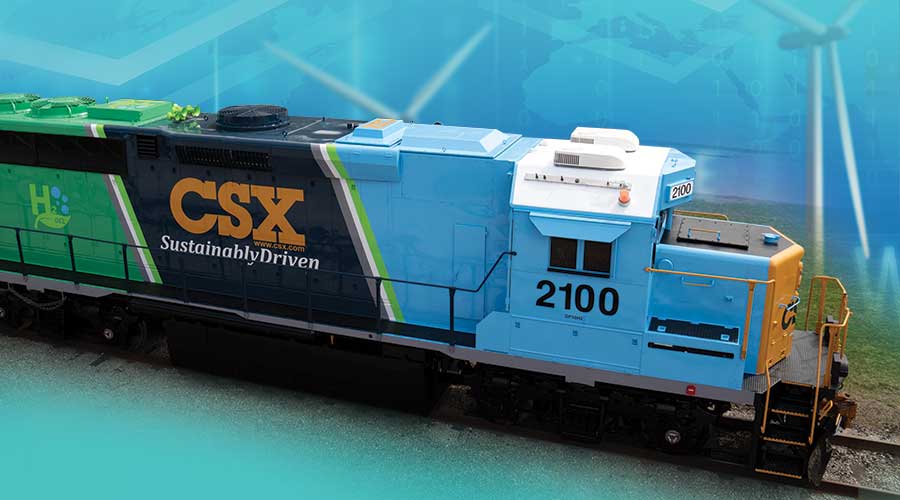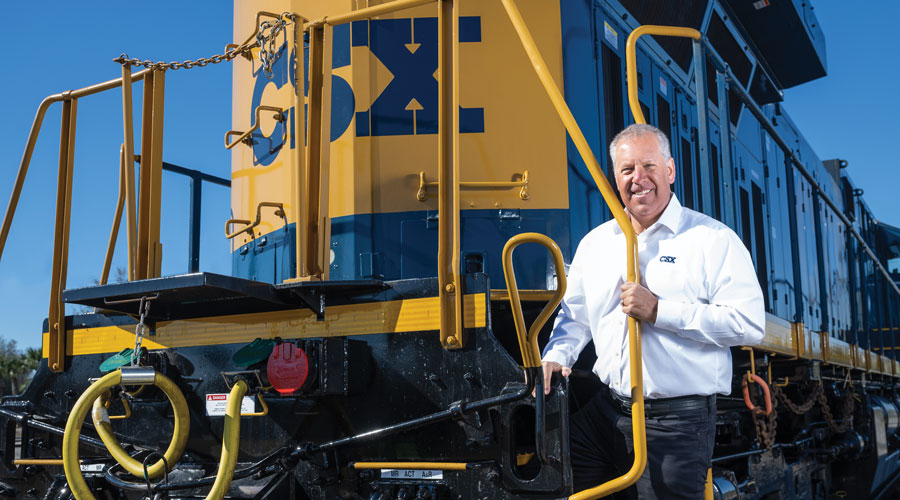Stay updated on news, articles and information for the rail industry
October 2018
Rail News: CSX Transportation
James Foote keeps the changes coming at CSX, with the intermodal franchise a fresh focus
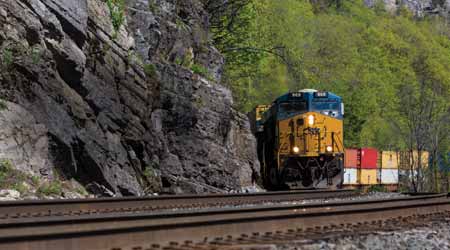
By Jeff Stagl, Managing Editor
There’s been one constant at CSX since E. Hunter Harrison was installed as leader in March 2017: change. From Day One until his death on Dec. 16, 2017, Harrison made constant changes while trying to mold CSX into his lean, agile and dependable type of railroad.
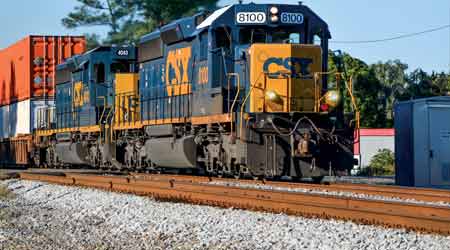
He dismissed several senior executives and replaced them with former members of his senior management teams at CN and Canadian Pacific. He shrank the workforce. He closed yards. He rationalized locomotives and freight cars. He sold off unwanted lines. And he shepherded the integration of his many-times-proven precision scheduled railroading (PSR) operating plan at CSX to boost productivity, cut costs and reduce the operating ratio.
In place for many years at CN and CP — and to be launched in October at Union Pacific Railroad under its Unified Plan 2020 — PSR is designed to improve service reliability, boost operating efficiency and reduce network complexity by shifting the operational focus from moving trains to moving individual rail cars. The goals: minimize car dwell time and classification events, reduce locomotive requirements and balance train movements to improve crew and asset utilization.
Change also has colored the short tenure of current CSX leader James Foote, who reteamed with Harrison at the Class I in October 2017 as executive vice president and chief operating officer. Foote served under Harrison for more than 10 years at CN, rising to EVP of sales and marketing.
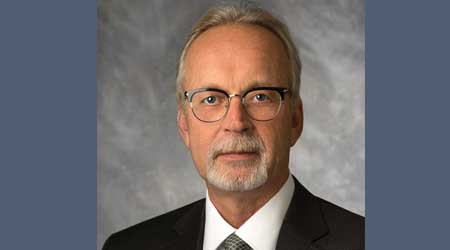
He became CSX’s president and chief executive officer in late December 2017 shortly after his Harrison’s death.
Since then, Foote has been trying to carry on his predecessor’s mission to transform CSX into North America’s best performing railroad both operationally and financially while instituting several of his own modifications. The adjustments reflect his more than 40 years of rail industry experience in finance, operations, sales and marketing.
Foote is striving to ensure PSR is executed properly on a daily basis now that the plan has been rolled out and customers are better informed of any impacts from the operating plan. He’s also revamping the company’s culture so employees recognize the need to be more service- and customer-oriented.
Plus, Foote is emphasizing strict adherence to individual car trip plans to improve service delivery and asset usage, and a heightened commitment to safety while operational performance undergoes enhancements.
Moreover, he’s trying to advance a significant and complicated change: transforming the intermodal franchise to operate more effectively and be better positioned for growth.
For Foote — who has more than a decade of experience as a Class I chief marketing officer — it’s all about doing what you say you are going to do for a customer. If CSX walks that talk, the dominoes will fall in place, leading to fulfilling the be-a-well-run-railroad objective, he believes.
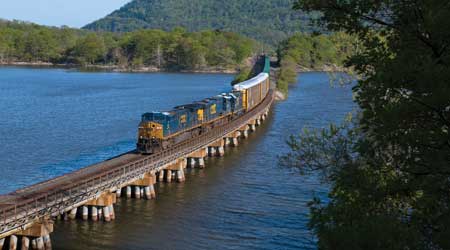
“In summary, what are we trying to do? Drive efficiency, improve the network and improve the quality of our service, which will reduce our costs. [Then] leverage that low-cost structure with higher-quality service to grow the business,” Foote said March 1 at CSX’s investor conference in New York City. “That’s why I’m confident when I say that we’re going to be the best-run railroad in North America, and why I say with confidence that we will have an operating ratio of 60 [in about three years].”
To meet its goals, CSX will need contributions from each employee and guidance from each person on the senior team, which sports several new and reassigned members.
Earlier this year, Foote added another Harrison connection to the team by installing Ed Harris as EVP of operations. Harris worked with Harrison at CN for nearly a decade, mainly as head of operations. In addition, Foote appointed Mark Wallace — who served with Harrison at both CN and CP — EVP of sales and marketing in July after naming him EVP and chief administrative officer in January. Wallace had joined Harrison’s team at CSX in spring 2017 as EVP of corporate affairs and chief of staff.
Other senior and executive appointments made under Foote’s watch include Diana Sorfleet as EVP and chief administrative officer; Angela Williams as VP and controller; Brian Barr as SVP of mechanical and engineering; Bob Frulla as SVP of operations East; Jermaine Swafford as SVP of operations West; Jamie Boychuk as SVP of network operations; James Schwichtenberg as VP and chief safety officer; Shon Yates as VP of coal; and Amy Rice as VP of intermodal operations.
All-out effort to emulate UPS
Foote is trying to foster a total team effort because he wants CSX to operate more like UPS. By scheduling a trip for and tracking the progress of each rail car — similar to how UPS sets a delivery time for every package and monitors all movements — the Class I can eliminate many train stops and car handlings, Foote believes.
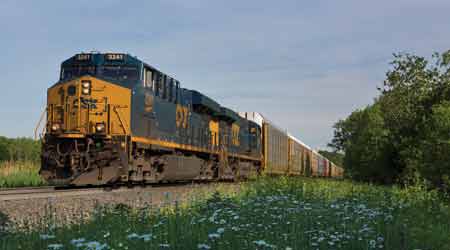
The railroad also then can better meet delivery promises. “I’m going to worry just like UPS would do” when a customer is told a package will be delivered to their front door in 48 hours and in the morning, Foote said during CSX’s second-quarter earnings conference on July 17.
The Class I needs to sweat the details to ensure promises are fulfilled, such as when a shipper is told a car will make it to its destination in 114 hours. CSX’s top brass doesn’t believe it’s good enough to meet that commitment four out of five times.
“[We’re] going to do that 95 percent of the time,” said Foote.
By fundamentally changing the way assets are handled and the network is run, service performance can reach a high level that helps promote business growth and enables the company to charge higher rates, he said.
“Those tens of thousands of touches per day, those hundreds of thousands of touches that we’re used to, that did nothing but slow down the process and make us have poor service for the customer,” said Foote. “No longer are we just like everybody else. No longer are we just a commodity. We are now a service.”
Therefore, strict trip plan compliance is vital to becoming UPS-like. CSX began scheduling a trip and providing a delivery time for each car earlier this year.
A trip is monitored from the moment a customer releases a car to the moment it’s delivered. If the railroad meets the delivery time communicated to a customer within a two-hour window, it complied with the trip plan; if not, the trip plan is considered a failure.
Eye on flawless execution
Tracking each car enables managers to react to any problems, learn why they occurred and ensure they’re not repeated.
“Why did a car not make it as scheduled? It could have been something in the terminal. It could have been something with a piece of equipment. It could have been something at the interchange. It could have been something at the customer’s facility. It could have been on the line of road. Any number of those things can happen with any single car on any single day,” said CSX EVP and Chief Financial Officer Frank Lonegro Sept. 5 at Cowen and Co.’s Global Transportation Conference in Boston.
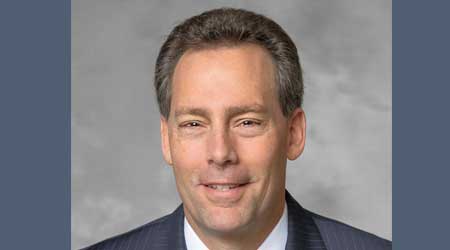
PSR is all about “executing at a flawless level” while managing thousands of assets, thousands of people and thousands of miles of track, he said.
“It’s about doing things that are balanced, scheduled, repeatable and executable,” said Lonegro.
Currently, CSX’s trip plan compliance on average reaches about 80 percent for intermodal traffic and 70 percent for cars moving other commodities — figures that concern Foote.
“We get to a destination with that two-hour cushion over a three-day operating period in the 80 percent range. That’s not acceptable,” he said during the earnings conference. “That always [happens] for a number of different reasons, so we need to just continue to be able to work to eliminate the causes of failures. We need to get that up to 100 percent.”
A recently formed a regional operating structure might help in that regard. Transportation, mechanical and engineering forces are governed by four regional leaders and two super-regional leaders to place more emphasis on coordination, communication and decision-making at the local level. The structure is designed in part to boost service reliability.
“We’re looking for every opportunity to take out handlings and out-of-route miles in the operating plan itself,” said Lonegro at the Cowen event. “We have all the regions focused on trip plans and compliance, and really getting down to chasing every single car and every aspect of its trip. It’s a very important pivot for us.”
So is changing the corporate culture. Employees need to recognize that if there’s going to be a service failure, they need to go above and beyond the call of duty to ensure a car makes a connection on the next train, Foote said at the earnings conference.
“What does a UPS employee do when they see that a box is not going to get in a truck? They run behind the truck down the road to make sure the box gets on the truck,” he said. “Our guys kind of wave to the train, ‘See you later,’ and the car runs a day later. So it’s all kinds of changes that we need to take place in order to get better.”
Culture shock
Foote realizes there was “a significant amount of shock to the system” for rank-and-file workers when the railroad began to implement PSR. So, everyone from the top down needs to be better educated about the need for and thinking behind the new operating plan, he said.
“We’re communicating to all of our employees about what we’re attempting to accomplish. And my sense is that even though we’re in the early stages of this transformation, everyone is moving and pulling in the right direction,” Foote said.
For example, CSX now employs an extensive, several-weeks-long training program for front-line supervisors that’s designed to help them more fully understand PSR. They then can coach the workers under them about the operating plan. In addition, the Class I recently rolled out a new front-line manager training program that focuses on PSR and includes a mix of exercises at CSX’s Jacksonville, Florida, headquarters and in the field.
The Class I also uses CSX TV and other resources to communicate the company’s moves with rank-and-file workers.
Keeping customers in the loop is a top priority, too, Foote believes. The railroad needs to have “very good and open communication” with shippers, especially about train design changes, he said during the earnings conference.
“It involves terminals and potential terminal consolidations,” said Foote. “And we will do this very methodically and logically and appropriately.”
To improve communication, CSX now provides each shipper a direct phone number with a point of contact so they don’t have to go through endless phone loops to reach the right representative while calling the railroad’s headquarters. The change helps solve customers’ issues at the local level, senior executives believe.
In addition, sales and marketing staff try to help customers understand there are existing resources and tools they can use to help resolve a problem, such as the ShipCSX online application that also enables shippers to check rates, order and track cars, and pay bills.
A function of ‘dysfunction’
As for intermodal customers, the main point Foote & Co. want to communicate to them is the network soon will be vastly improved to boost transit speed and reliability to a truck-like degree.
Intermodal is a key traffic segment — accounting for 40 percent of annual volume and 20 percent of yearly revenue — and the senior team is in the early stages of defining that book of business for the future.
The network to a large degree is “dysfunctional” since CSX operated intermodal as a stand-alone entity for many years, senior execs say. So, it needs to be reconfigured and more properly integrated into the company, they believe.
“Our intermodal network needs a ton of work in order to become an efficient part of our system that it needs to be,” said Foote during the earnings conference. “And we really are just beginning to get in there and start to figure out how to rationalize that big part of our business so we can become much more efficient and have a much better product for our customers.”
CSX plans to reduce operational complexity by transitioning to a direct routing model for intermodal moves instead of the previously employed hub-and-spoke model that required many terminals, said Lonegro at the Cowen event. The new model calls for increasing the block size within a terminal to reduce handlings and lengthening intermodal trains to drive operating leverage, he said.
“We’re looking to reduce terminal handlings with fewer crane lifts, which obviously lowers dwells and gives you faster transit time for the customer,” said Lonegro.
The railroad also plans to streamline origins and destinations by reducing the number of lanes it offers — especially routes with very low traffic densities — and consolidate endpoints. Moreover, the Class I needs to improve interchanges, such as in the Chicago area where CSX tends to lose a day of transit time due to congestion, said Lonegro. The Class I is employing more rubber-tire interchanges in Chicago but is analyzing other locations — such as St. Louis and Memphis, Tennessee — where a steelwheel interchange would be more fluid, he said.
“We’ve also engaged with other railroads to have new blocking protocols. That would have them block for us and we block for them, and it reduces the overall number of handlings in the transit move for the customer,” said Lonegro.
CSX executives are having “some very candid conversations” both internally and with customers about the intermodal network changes, he said. But if the railroad can’t effectively or efficiently move containers from a certain origin or destination, then it probably shouldn’t serve the particular terminal involved in such moves, said Lonegro.
“Now, we’re not going to do anything disruptive. We know we’re going into the peak season,” he said. “We will provide [customers] ample notice of any changes that we are going to make. And we won’t be making any additional network changes during the peak season.”
A complete re-think and rebuild of the intermodal franchise will take time to complete, perhaps well into 2019, said independent rail industry analyst and Progressive Railroading columnist Tony Hatch in an emailed report.
Focusing PSR first on the merchandise network, then on the intermodal franchise — as well as continuing to pursue line rationalizations — “will be the lead to the next phase of the CSX story,” he said.
Big changes, big challenges
The Class I figures to continue evolving in this transitional period, in part because it takes time to implement large changes in a large organization, said Bank of America Merrill Lynch analyst Ken Hoexter during a phone interview. While Harrison was a COO before becoming CEO, Foote largely was a CMO, so he can help customers who struggle with the transition, Hoexter said.
“With intermodal, they’re figuring out where to serve and how to serve, to adjust and align to the marketplace. They’re determining how to get better at service, and are learning customers’ behavior,” he said.
A big challenge facing Foote as he aims to accomplish those objectives is changing the organization’s culture, especially since CSX is an amalgamation of several other companies, such as Chessie System and Seaboard Coast Line, said Hoexter. Employees tend to say, “That’s not how we’ve done it in the past,” he said.
But the Class I’s strong financial and service metrics of late will help workers understand that the new ways can work, Hoexter believes. To that end, CSX in Q2 beat analysts’ expectations by boosting net earnings from $510 million to $877 million on a year-over-year basis. In addition, revenue rose 6 percent to $3.1 billion, operating income jumped 34 percent to $1.3 billion, operating expenses fell 8 percent to $1.8 billion and the railroad set a new quarterly operating ratio record at 58.6, down from 67.4 in the same 2017 period.
Service measuring sticks
Moreover, the following service metrics registered improvements in Q2 on a year-over-year basis: train velocity rose from 16.2 mph to 17.4 mph; average terminal car dwell time dropped from 10.9 hours to 9.7 hours; and car miles per day climbed from 110.5 miles to 123.8 miles. In addition, locomotive efficiency, as measured by gross ton miles per available horsepower, continued to increase.
Although CSX is posting top-line growth — a big focus for Foote — the railroad also needs to keep concentrating on network fluidity and reliability, a la the trip plans, said Credit Suisse Group AG analyst Allison Landry via phone last month. That will help create more capacity, she believes.
“They need to get their house in order as the peak season is upon us and be ready to meet customers’ expectations,” said Landry. “The indications are it will be a good holiday shopping season.”
Getting the house in order figures to be a long exercise. And it will hinge on: A) completely immersing PSR into the organization to improve efficiency, drive out costs and bolster service quality; and B) looking at each business sector differently instead of the ways a railroad typically approaches a commodity, Foote believes. That just might turn out to be a winning combination for CSXers.
“When you add those two items together, you get significantly improved performance, operationally and financially,” said Foote at the March investor conference.
Email questions or comments to jeff.stagl@tradepress.com.


 2025 MOW Spending Report: Passenger-rail programs
2025 MOW Spending Report: Passenger-rail programs
 Gardner steps down as Amtrak CEO
Gardner steps down as Amtrak CEO
 Guest comment: Oliver Wyman’s David Hunt
Guest comment: Oliver Wyman’s David Hunt
 Women of Influence in Rail eBook
Women of Influence in Rail eBook
 railPrime
railPrime





